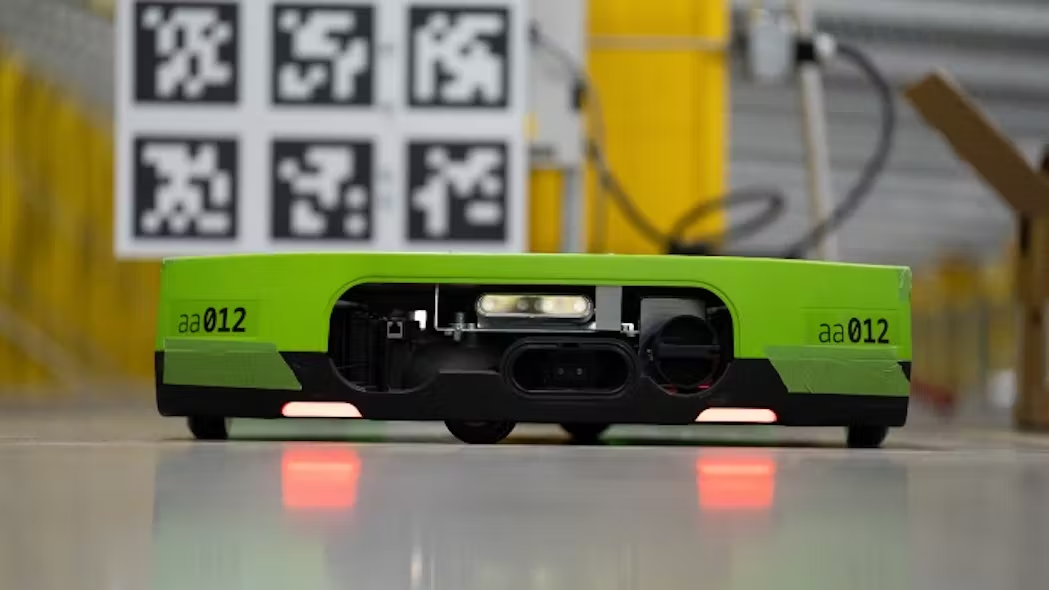Hybrid AI-powered computer vision combines physics and big data
SOURCE: HTTPS://WWW.SCIENCEDAILY.COM/
AUG 14, 2023
Amazon is Testing an Autonomous and Collaborative Robot
SOURCE: VISION-SYSTEMS.COM
AUG 29, 2022

Amazon (Seattle, WA, USA; https://www.amazon.com/) is experimenting with an autonomous robot designed to collaborate with people.
Amazon isn’t alone. Other large logistics and warehousing operations also are testing these technologies, according to Tom Brennan, President of Artemis Vision (Denver, CO, USA; https://www.artemisvision.com/). “This seems on par with everybody,” he says. The robots, often called autonomous mobile robots (AMRs), are typically involved in moving products around a warehouse, such as bringing items to employees or machinery involved in packing orders, he explains.
However, unresolved questions remain about how to incorporate the use of these technologies into logistics operations in a cost effective and safe manner.
In Amazon’s case, the autonomous robot is called Proteus, and Amazon plans to incorporate it into the same physical spaces where people work. Using perception and navigation technology developed in-house, “the robot was built to be automatically directed to perform its work and move around employees—meaning it has no need to be confined to restricted areas,” as is currently the case, Amazon says in a news release.
While Amazon did not disclose the vision technologies that Proteus is equipped with, Brennan says many of these types of robots incorporate time-of-flight (ToF) based 3D vision.
Proteus will initially move GoCarts, which are tall, wheeled shelving systems, around the outbound area of its warehouses, which Amazon refers to as fulfillment centers. However, the goal is for the robot to bring the shelving units directly to employees situated at workstations in the fulfillment centers. Currently, employees move the shelving units around manually, Amazon says.
In the news release, Amazon also notes that it has been adding robotic automation to its logistics operations since its $775-million acquisition in 2012 of Kiva (Woburn, MA, USA), a robotics company, which the ecommerce giant renamed Amazon Robotics. "Robotics and advanced technology support how we manipulate, move, store, sort, pack, and identify goods in our customer fulfillment process," the company says in written answers to questions from Vision Systems Design.
The company has more than 185 fulfillment centers, including 50 of them that incorporate more than 520,000 individual robotic drive units, the company told VSD.
Brennan has at least one client organization that also is experimenting with autonomous robots.
However, he says that the technology has operational challenges that would need to be overcome before the robots could be used in a production environment. First, he says, they move slowly—more slowly than people—to ensure their safe use around humans. Second, when they detect an obstacle, they stop, leading to choke points in the movement of goods and orders through a warehouse. “People leave things around the warehouse, or stuff gets left in the way,” he explains. Unlike people, the robot can’t stop, move the obstruction, and then proceed; it waits for an employee to fix the problem.
Another issue: most existing warehouse structures were not designed with aisles wide enough t accommodate the robots but designing larger aisles may not be cost-effective from the perspective of total overhead.
Other Automation Technology at Amazon
Amazon is not only experimenting with the autonomous and collaborative robot. In addition to Proteus, another robot Amazon discussed in the news release is called Cardinal, which the company describes as a “robotic workcell” that selects a package out of a pile, lifts it, reads the label, and places it in a GoCart. Cardinal was developed with a combination of computer vision and machine learning, Amazon notes without providing other details. The company is testing Cardinal with packages of up to 50 pounds and plans to deploy the technology in fulfillment centers in 2023.
Amazon also has been working to develop Amazon Robotics Identification (AR ID), which is a scanning capability involving computer vision and machine learning. AR ID would allow Amazon to automate a manual process in which employees pick up and then scan each package that arrives at their workstations.
With AR ID, Amazon says a freestanding camera system that runs at 120 fps automatically scans barcode labels as packages are handled by an employee working nearby. This process allows employees to handle packages with two hands, rather than holding a package in one hand and a barcode scanner in the other hand. "We believe this technology will help eliminate manual scanning, reducing the need for micro movements required for scanning," and thus improving employee safety, Amazons says.
LATEST NEWS
WHAT'S TRENDING


Data Science
5 Imaginative Data Science Projects That Can Make Your Portfolio Stand Out
OCT 05, 2022

SOURCE: HTTPS://WWW.SCIENCEDAILY.COM/
AUG 14, 2023
SOURCE: INDIANEXPRESS.COM
OCT 24, 2022